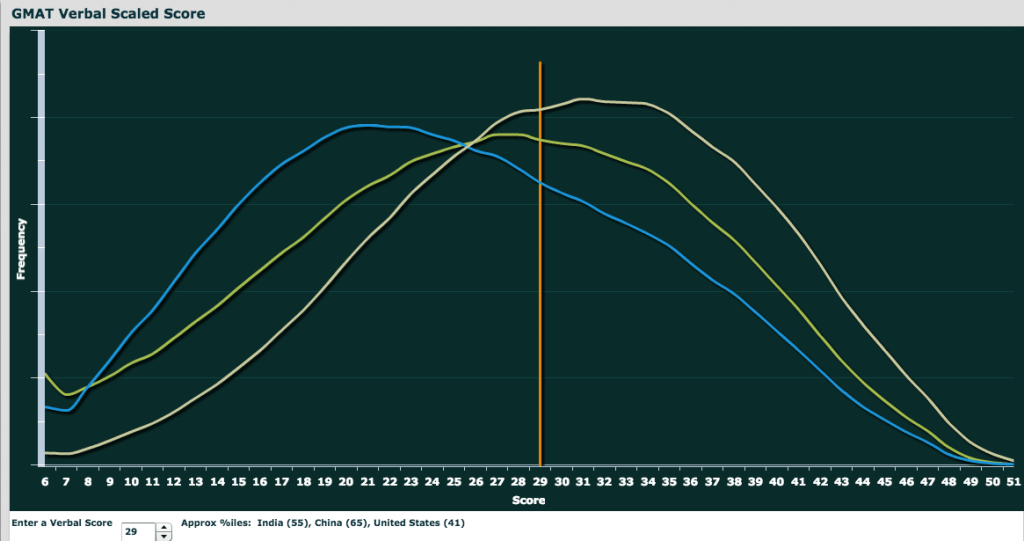The big news is that on 15th June, 2017, GMAC announced the GMAT Select Section Order, wherein GMAT takers can choose the order of the sections that they attempt. This means that now a test taker can actually start the GMAT from the Verbal section!
If you have taken the GMAT or have been preparing for it, you know that this is a huge deal. Taking the GMAT is a lot about conserving your mental energy towards the end, especially while doing reading comprehension passages.
“
On 15th June, 2017, GMAC announced that GMAT takers can choose the order of the sections that they attempt.
If you are confused about what the GMAT Select section order means to *your* GMAT scores OR if you are wondering whether you should retake the GMAT, you have come to the right place!
In this article, we are going to deconstruct the GMAT Select Section Order so you know exactly what to do.
Let’s get started:
What is the GMAT Select Section Order?

GMAC has made an announcement on its official website.
Starting 11th July, 2017, GMAT is going to give you three options:
Option 1: The same structure as before
1. Analytical Writing Assessment
2. Integrated Reasoning
3. Quantitative
4. Verbal
Option 2: Verbal section first
1. Verbal
2. Quantitative
3. Integrated Reasoning
4. Analytical Writing Assessment
Option 3: Quant section first
1. Quantitative
2. Verbal
3. Integrated Reasoning
4. Analytical Writing Assessment
“
You just need to walk into the GMAT center and start the test by picking the order you want.
There is no need for you to select the options beforehand. You just need to walk into the GMAT center and start the test by picking the order you want. If you have already scheduled the test, you do not need to do anything different now! Just go and do the exam in the preferred section order!
Here are a few quick facts about the new change that will help you understand it better:
1) Students must make this choice in 2 minutes. Otherwise, the test begins using the current default structure.
2) Students will not be shown the “Profile Update” screen after they have taken the test. Rather, they are presented their unofficial scores immediately after the test. The Profile Updates can be done anytime before or after the test from mba.com
3) The official score reports do not display order of test taking to the colleges.
4) The GMATPrep and ExamPack update (official tests available on mba.com) is scheduled for 31st July and our existing licenses will be valid. The update will not contain content updates. It will just be a UI overhaul with the new selection style offered.
I have done a quick analysis of the GMAT Select Section Order in this video:
Would the GMAT Select Section Order affect my GMAT scores?

A huge YES! And in a positive way.
Here’s what GMAC had to say about it, officially:
“Our pilot findings concluded that taking the exam in different section orders continues to maintain the quality and integrity of the GMAT scores.”
– Ashok Sarathy, vice president, Product Management, GMAC.
The problem with their analysis (and we pointed it out to GMAC when the study was shared with us) is that they used a computer simulation to see the probability of a student answering a question correctly or incorrectly.
The problem with computer simulation is that it discounts how GMAT students really feel when they take the test. It doesn’t take into consideration the stress of the exam. It doesn’t take into account how tired a student actually feels by the end of it all.
A lot of GMAT is about conserving your mental energy, especially when it comes to the Verbal section. The reason why many students end up running into time management issues is that they take way too much time as the processing power of our brain significantly reduces after the first few hours of the test. (There is a term for this, it is called “decision fatigue”).
Here is what we had to say about the topic.
Now, with Verbal as the first section, you can actually push your scores by a few raw scores at least. This means a huge difference to your overall score.
“
The reason why many students end up running into time management issues is because they take way too much time as the processing power of our brain significantly reduces after the first few hours of the test.
If you are scoring in the lower 30s in Verbal, with a constant Quant score (say 49) you will end up with the following splits:
Q49 V32 -> 640
Q49 V36 -> 700
Q49 V40 -> 730
Even during the earlier “trial” that was conducted by GMAC, we saw several of our students at CrackVerbal scoring higher (than their practice test scores) on the Verbal section because of the shift in the order (needless to say, they picked Verbal as the first section).
Hence, if you have not taken the GMAT yet, the GMAT Select Section order might mean that you could actually do a lot better than you would have before this change.
Should I reschedule my GMAT dates given this new GMAT Select Section Order?

If you think you need more time to process this change, OR if you think you would do better with Verbal as the first section (or Quant for that matter), and think you need more practice with this change in order, you should reschedule the dates. At this point, rescheduling itself is rather easy!
“
CrackVerbal’s advice to you is to consider starting your exam with either Verbal or Quant. Which of the two sections you should start with depends on your confidence in the Quant section.
GMAC has announced that you can simply call GMAC Customer Service to reschedule your exam. If your request is received within seven days of the announcement, both your reschedule fee and phone fee of USD 10 will be waived. Given that GMAC made the announcement on June 15, you have until June 22 to reschedule without incurring any expenditure.
CrackVerbal’s advice to you is to consider starting your exam with either Verbal or Quant. Which of the two sections you should start with depends on your confidence in the Quant section. If you think starting with Quant can give you an edge, pick Option 3. Otherwise, stick to Option 2.
Should I retake the GMAT with the GMAT Select Section Order?

Here are three scenarios in which you should consider retaking the GMAT:
Case 1: You did not do as well as you could have done in Verbal
If you did not do well and you think the reason is that you could not focus well on the Verbal section, you should definitely consider retaking the GMAT.
As mentioned earlier, even a slight increase in your Verbal scores can make a huge difference to your overall GMAT scores. A USD 250 investment for such an improvement is well worth it.
Case 2: You did not do well in the test because of stress or fatigue
If you are not a great test taker because you get very stressed about the test, especially Verbal, or you lose all your mental energy during the Verbal section (especially reading comprehension), you should definitely retake the GMAT.
You just need to make sure that you re-strategize the way you approach the GMAT. If you get a higher GMAT score, you can “wipe the slate clean” by canceling your previous scores.
Case 3: You did reasonably well but feel you can do better with the revision
If you think you can improve your GMAT scores by even 30-40 points because of the new GMAT Select Section order, retaking the test would certainly be worth it, especially if you belong to the demographically disadvantaged background, such as Indian – IT – Male.
This is especially true if you are a reapplicant, and feel you could improve your chances with a better GMAT score.
Will the GMAT Select Section Order affect B-School applications in 2017-18?

Definitely!
For the current admissions season, i.e., class starting Fall 2018, expect the average GMAT scores for most top schools to increase significantly.
In recent years, the average GMAT scores at top schools have been shooting through the roof. For example, Stanford has its latest average GMAT score at an obscenely high 737!
By making such changes, GMAT has made it a lot easier for Indians and the Chinese – India and China are the two other countries in the top three test taking countries, apart from the US. Asian countries have stellar GMAT Quant scores but suffer in the Verbal section.
“
For the current admissions season, i.e., class starting Fall 2018, expect the average GMAT scores for most top schools to increase significantly.
Here is how Indians and Chinese do on the GMAT Quant section (compared to Americans):

Here is how they compare against the Americans in the Verbal section:

You can expect the graph to change considerably because Indians and Chinese will start performing better in the Verbal section.
It would come as no surprise if schools such as Stanford and Harvard breach the 740-mark (corresponding to the 97th percentile currently), as their average GMAT score.
Closer home, this would affect the overall GMAT scores at ISB and the IIMs. If their average GMAT cutoff was around 700, expect it to go up as well.
“
You can expect the graph to change considerably because Indians and Chinese will start performing better in the Verbal section.
Of course, if you have a great profile, you can sneak in with a slightly lower than average GMAT score for that school. However, if you do not want to take a risk, as an Indian applicant, you need to score at least 30-40 points above the average GMAT score for that school.
Why is the GMAT introducing the Select Section Order?

This is actually consistent with a lot of changes that GMAT has been doing over the last year, especially after Sangeet Chowfla took over as the CEO of GMAC.
Over the last several years, GMAT has been trying to fight a battle with GRE over the MBA admissions turf. The GMAT was traditionally used for MBA programs and GRE was used for MS programs only. However, this changed in 2016 when ETS lost the GMAT contract. So ETS decided to approach B-Schools to use GRE as an eligibility criterion for MBA programs!
More here:
Though GRE is still a long way away (9 out of 10 applicants to MBA programs use the GMAT over GRE), GMAC doesn’t want to take the risk. It wants to make the GMAT as convenient as possible. There should be absolutely NO reason for you NOT to take the GMAT.
“
Over the last several years, GMAT has been trying to fight a battle with GRE over the MBA admissions turf.
Another reason is GMAT stands to make a lot of money if students end up retaking the test, or just if more people take the GMAT because it has become “easier”. However, “easier” is a relative term because if the test becomes easier for everyone, people will start scoring higher, making it a level playing field.)
Here are some of the other changes that have been introduced in the last few years:
March 2016: You can reinstate your GMAT score even if you canceled it earlier.
March 2016: You can now cancel your GMAT scores online after you leave the test center.
July 2015: You can take the GMAT within 16 days of your previous attempt (as opposed to the earlier 31 days period.)
July 2015: You can choose not to report your canceled scores to schools.
January 2015: You can get an in-depth analysis of your GMAT performance by accessing the GMAT Enhanced Score Report (ESR.)
July 2014: You can preview your unofficial scores before deciding whether to report or cancel them.
If you are looking at a common thread among these changes, it is this: most of the “facilities” cost you money, or encourage you to use a “facility” that will cost you money.
We will keep updating this article when we get more information about the Select Section Order change. Meanwhile, we would love for you to share this article with other GMAT test takers who might benefit from the article.
Please feel free to comment below if you want to share your thoughts on the matter, or if you want to learn more. We respond to all questions.


